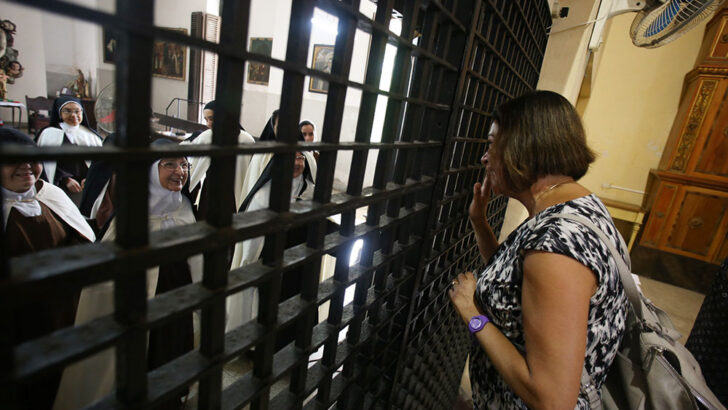I’ve often wondered what it is like to experience a vocation as a cloistered nun, and now I think I understand what it’s all about. Catherine Coldstream is an Englishwoman who grew up in a somewhat Bohemian household, and after her father died, she felt adrift in the world.
In her twenties, she became a Catholic and was then drawn to join a Carmelite order at Akenside Priory in Northumberland. She was not only seeking God; but the “intensity of the cloister”, and the “spirit and charism” in the tradition of St Teresa of Avila and St John of the Cross.
This was the 1990s and for twelve years, Catherine lived the Carmelite life, discarding all earthly concerns. She learned to practice the ‘solitude, silence and intense prayer’ of life behind the grille: she felt glad of that grille, and in her bare cell, Catherine found a sense of sanctuary. Clothed in white to be professed as a Bride of Christ was a ritual of great meaning.
Nuns were, even in the 1990s, adapting to the changes ordered by Vatican 2, and there were tensions between the old traditions and the new changes”
I can see exactly what calls women (and of course men) to this monastic life: there is something serene, even reassuring, about the detachment from the hurly-burly of the world and submitting oneself to ‘God’s inscrutable will’.
I can see that the notion of effacing oneself, letting go, and following a discipline set down over the centuries, can almost be a relief from the ego-driven struggle of everyday life.
And yet the modern world did intrude into the monastic one, as Catherine tells it in her remarkable recent memoir, Cloistered. Nuns were, even in the 1990s, adapting to the changes ordered by Vatican 2, and there were tensions between the old traditions and the new changes.
Rules
The old rules had been very austere: the sisters had to have a chaperone even seeing visitors from behind the grille, and they were not permitted a cup of tea at breakfast – only sugared water. No news media penetrated the priory– until the death of Princess Diana in 1997, announced by the Prioress to an astonished assembly of sisters.
We cannot but feel awe for anyone who has committed their time to the discipline of the cloister”
There were also personality clashes within the monastery, and after those 12 years, Catherine literally ran away. Other sisters left as well; some had psychological breakdowns; some came out as gay.
Catherine herself eventually married, contentedly. And yet, she feels that she’s “still a Carmelite inside”: it was such an intense experience that it will always be with her, as is her sense of the presence of God.
I’d never have made a nun – the vow of obedience is far too difficult, as Catherine Coldstream found. Yet I envy the experience of the cloister. It seems to have such a profound impact on the personality. It is such a contrast to the clamour of our everyday lifestyles, that we cannot but feel awe for anyone who has committed their time to the discipline of the cloister.
**
There was a flowering of Ukrainian art in the 1920s when, after the tumult of the First World War and a brief period of Ukrainian independence, talented artists emerged, mixing national and peasant traditions with modernist trends like Cubism. Mykailo Boichuk, Oleksandr Bohomazov and Ivan Padalka were among the best-known of these artists, and Boichuk, gave his name to a Ukrainian school of painting.
Come the 1930s and Stalin embarked on a killing-spree of anyone he deemed ‘nationalist’, ‘bourgeois’, ‘cosmopolitan’ or any other label he gave to those who deviated from his own Communist brand. Boichuk was executed along with Padalka and another gifted artist, Vasyl Sedliar. Some of their work was also deliberately destroyed.
With their stunning use of colour, fusing a rural past with 20th century abstracts, these art works are now recognised as a vital part of Ukraine’s culture and history. An exhibition currently showing at London’s Royal Academy in Piccadilly focuses on this Ukrainian art, and it would be great to see it brought to Ireland. Many young people in Irish education now have a Ukrainian heritage or connection with that country.
A bishop’s beautiful daughter
Dr Justin Welby, as Archbishop of Canterbury and head of the Anglican church, has sometimes been criticised for being too worldly – he was in business before getting ordained. Paul Morland, the British demographer, has even criticised the Church of England for not being sufficiently pro-natalist.
But now Dr Welby has made an affecting disclosure about how he and his wife had to resist pressure from doctors to encourage an abortion, when their unborn daughter was diagnosed with dyspraxia (difficulties with co-ordination).
He told the Synod that medics underlined how expensive – and undesirable – a disabled child would be. The Welbys defied the medical advice and now cherish their precious daughter Caroline. Dr Welby urged the new Labour government to ensure that this does not happen on the NHS, and to support disabled children and their parents. Good for him.


 Mary Kenny
Mary Kenny Picture caption: An American visitor greets cloistered Carmelites at the Church of St Joseph and St Teresa of Avila in Havana, Cuba. (CNS photo/Tom Tracy)
Picture caption: An American visitor greets cloistered Carmelites at the Church of St Joseph and St Teresa of Avila in Havana, Cuba. (CNS photo/Tom Tracy)